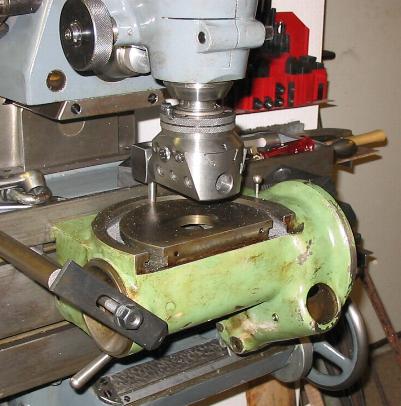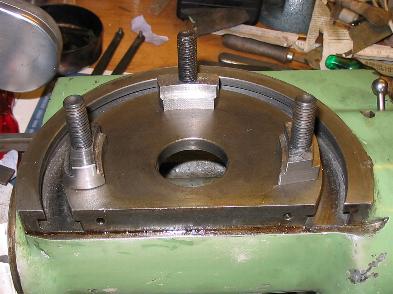 Vintage Workshop
Vintage WorkshopServices for Brough Superior motorcycles and their contemporaries
 Vintage Workshop
Vintage WorkshopServices for Brough Superior motorcycles and their contemporaries |
last update: 7/2005
The decision to buy an FP2 has given me a hard time, as I truly love my
little FP1.
Maybe I will have to sell some bikes and keep them both... :-)
| I stumbled across this picture on a machine merchants internet page.
What struck me was that, in contrast to the generally not very sympathetic
way of presentation, the paint looked still quite nice, which prompted me to
inquire. When I learnt that the machine was not too far from my place (well, some 250 kms) I decided to undertake the journey and have a look at it. The main bed ways seemed to be in quite good shape, but closer inspection
made it obvious that the machine had a number of defects. The vertical head
had been mounted by the time I came to look, but the bevel gears gave some
nasty noises when I turned the spindle over. I also found that the taper of
the horizontal spindle did not run quite true. The pro's were that the machine seemed otherwise well kept, and having spent its life in a company making small scale railway trains it did not seem to have had an unduly hard life. Anyway I went back home deciding I would only buy it if the seller offered me a substantial discount. He seemed a bit disconcerted when I told him about my findings, but we did not come to an agreement. |
|
| In the weeks to follow I had a look at a number of other FP 2's. Most of
them had their share of damages, and some were just too b...dy expensive.
Thus I made the seller a last offer which he grudgingly accepted. The seller had left the machine at the place where he had bought it, and I learnt it was my job to go there and make it ready for transport. A good advice from Franz Singer (in my view, the No.1 Deckel repairers in Southern Germany, I can only recommend their services) told me not to put the machine on a standard Euro palette to avoid disappointment with the movers telling me it tipped it over on the lorry... So I made a special palette from stout timber, measuring 1.25m * 1.25m, making sure that the machine did not protrude over the palette anywhere. The 35mm top planks allowed to bolt up the machine on its original mounting lugs which made it stand quite safely. I can only recommend this procedure; the cost was about 30 EUR and an hour of work, just try to work out how much much more time and money it takes to repair only a minor transport damage! |
|
| Job No. 1 was the vertical head. This machine came with the long head
that can be shifted by 200mm along the y axis to increase the y travel.
Which is a nice feature, but it makes the head a bit heavy and complicated.
I dismantled and cleaned it and found the mechanical parts in quite nice condition. |
|
| Even the dreaded bevel gears looked quite well.
Mind you, you can always get a new pair from Deckel, but this will set you back by a hefty 950 Euros, so I was rather pleased to find the gears in order! I found that the head had just been loosely assembled before selling the machine, for what reason ever. And the noise was just due to very poor mesh adjustment of the bevel gears. I readjusted them, monitoring the contact area with engineer's blue, and they ran smoothly again. |
|
| But unfortunately the head casting itself had damages to the T-slots.
I know this is not nice of me, but I suspect this is the reason why the front bit of the head has been exchanged before disposing of this machine. Which also explains why it wasn't properly adjusted. The T-nuts are one of the main problems with Deckel machines: Most of the T-bolt heads and nuts are just too small, and will damage the castings if they are done up too tightly. Once this has happened, things get worse and worse, as the pressure on the remaining surface under the bolt head gets very high when a part of it is already crumbled. Fortunately the land on one side was still pretty intact, and the damages on the other side were not too deep. I managed to clean up the slot by boring and facing it using the Wohlhaupter head on my trusty FP1. |
|
| The resulting slightly asymmetrical shape meant special T-nuts anyway, and I decided to put an end to this weak point by making much larger nuts matching the radius of the slot. |
|
| This meant another alteration to the head casting, as I needed a
kidney-shaped hole to put these nuts in. This makes the alteration visible,
but the big advantage is that the bearing surface is increased by about 400%
and I guess no one can tighten the screws so hard that this will result in a
critical surface pressure now! I will of course have to make a special kidney-shaped plug to close up the hole... |
|
| I bought a dividing had from a different source, but unfortunately I had to find the same kind of damage here... |  |
| .. which I put right in the same manner. Incidentally, I made all the nuts from 42CrMo4 steel, pre-heat treated to a tensile strength of 650 N/mm2. |
 |
| Bad things always come in triples, they say.
Guess what I found when dismantling the swivelling table: But now I already knew what to do... |
|
| to be continued... |
Any kind of feedback to
![]() is
appreciated
is
appreciated
(sorry, this is not a clickable 'mailto:' hyperlink. If you want
to write me, please type my address in your mailer. )